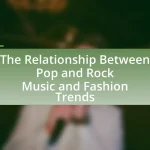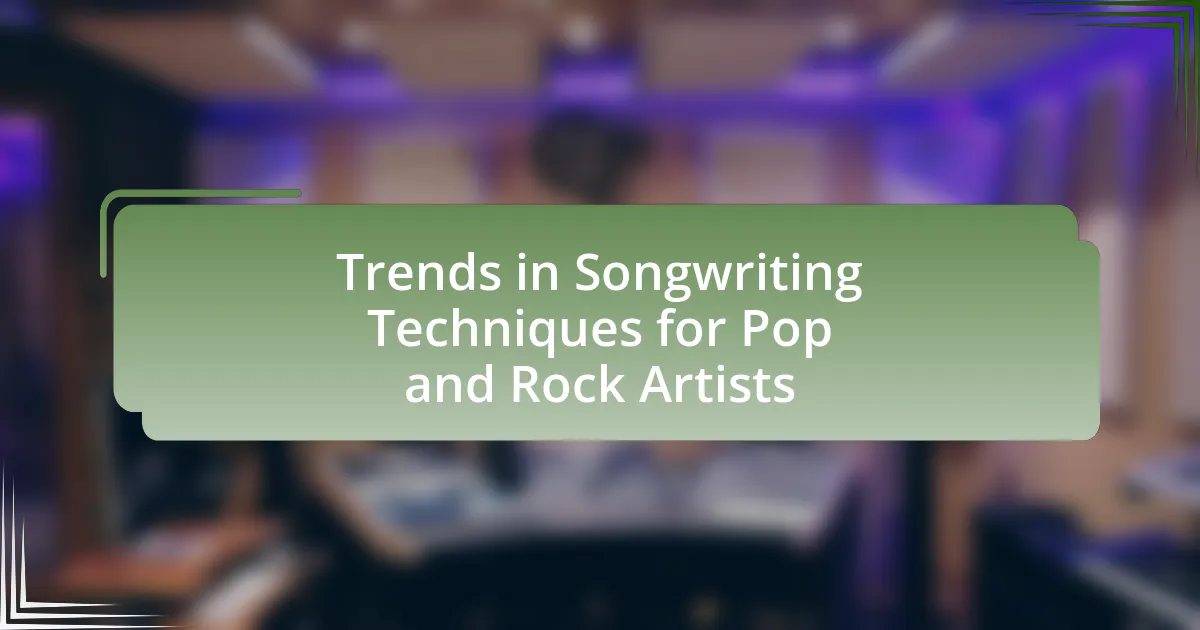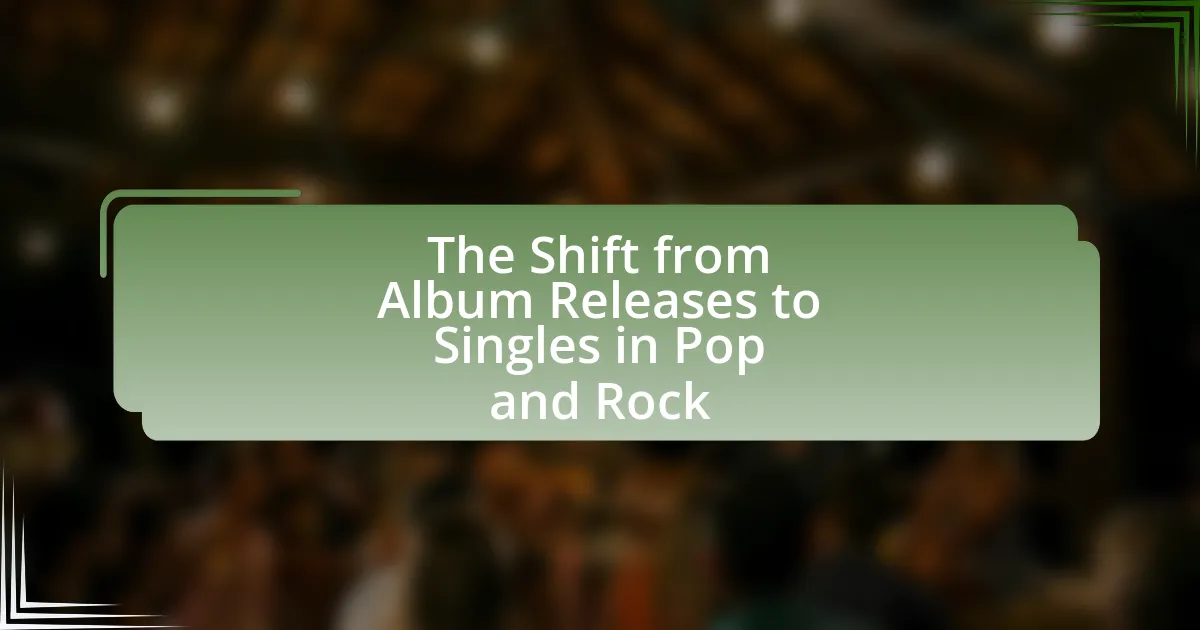The article examines the significant influence of pop and rock music on youth culture, highlighting how these genres shape identity, social norms, and values. It discusses the role of music in self-expression, the impact of lyrics on youth experiences, and how various music genres foster distinct subcultures. Additionally, the article explores the historical significance of music in social movements, the psychological effects on youth, and the challenges posed by explicit content and commercialization. It also addresses current trends in music consumption, the role of social media, and strategies for youth to critically engage with music content.

What is the Influence of Pop and Rock Music on Youth Culture?
Pop and rock music significantly influences youth culture by shaping identity, social norms, and values. These genres often serve as a form of expression for young people, allowing them to explore their individuality and connect with peers. For instance, studies show that pop and rock music can impact fashion trends, language, and attitudes towards social issues, such as gender equality and mental health. The popularity of artists like Billie Eilish and bands like Coldplay illustrates how music can inspire movements and foster community among youth, reinforcing shared experiences and collective identity.
How has pop and rock music shaped youth identity?
Pop and rock music has significantly shaped youth identity by providing a platform for self-expression and cultural connection. These genres often reflect the values, struggles, and aspirations of young people, allowing them to identify with the themes presented in the lyrics and the lifestyles of the artists. For instance, the emergence of rock music in the 1950s and 1960s coincided with youth movements advocating for social change, such as civil rights and anti-war protests, which resonated deeply with young audiences. Studies, such as those conducted by sociologist Simon Frith, highlight how music serves as a form of social identity, enabling youth to navigate their personal and collective identities through shared musical experiences. Furthermore, pop and rock music often challenge societal norms, encouraging youth to embrace individuality and diversity, which is evident in the rise of various subcultures associated with these genres, such as punk and grunge.
What role do lyrics play in expressing youth experiences?
Lyrics serve as a powerful medium for expressing youth experiences by articulating emotions, struggles, and aspirations that resonate with young audiences. They often reflect themes of identity, rebellion, love, and social issues, allowing youth to connect with their own life experiences. For instance, songs like “Smells Like Teen Spirit” by Nirvana encapsulate the feelings of disillusionment and angst prevalent among teenagers in the 1990s, illustrating how lyrics can mirror societal sentiments. Additionally, research indicates that music lyrics can influence youth behavior and attitudes, reinforcing the idea that they play a crucial role in shaping cultural narratives and personal identities during formative years.
How do music genres influence youth subcultures?
Music genres significantly influence youth subcultures by shaping identities, social interactions, and cultural expressions. For instance, genres like punk rock foster a sense of rebellion and nonconformity, often leading to the formation of distinct subcultures characterized by specific fashion styles, attitudes, and values. Research by sociologist Simon Frith highlights that music serves as a social marker, allowing youth to align themselves with particular groups, thereby reinforcing their sense of belonging and community. Additionally, hip-hop culture has been instrumental in promoting social awareness and activism among youth, as seen in movements like Black Lives Matter, which utilize music as a platform for advocacy. These examples illustrate how music genres not only reflect but also actively shape the dynamics of youth subcultures.
Why is pop and rock music significant in youth social movements?
Pop and rock music is significant in youth social movements because it serves as a powerful medium for expressing social and political messages. This genre often reflects the values, struggles, and aspirations of young people, making it a rallying point for collective action. For instance, songs like “Fight the Power” by Public Enemy and “Imagine” by John Lennon have historically galvanized youth around issues such as civil rights and peace activism. Additionally, the cultural impact of festivals and concerts, such as Woodstock in 1969, illustrates how music can unite diverse groups in pursuit of common goals, reinforcing the role of pop and rock as catalysts for change in youth-led movements.
How have artists used music to advocate for social change?
Artists have used music as a powerful tool to advocate for social change by addressing social issues, raising awareness, and inspiring action through their lyrics and performances. For instance, songs like “Fight the Power” by Public Enemy and “Imagine” by John Lennon directly confront systemic racism and promote peace, respectively. These tracks not only resonate with listeners but also mobilize them towards activism, evidenced by their use in protests and movements such as the Civil Rights Movement and anti-war demonstrations. Additionally, the global impact of artists like Bob Marley, whose music advocated for unity and social justice, illustrates how music can transcend cultural boundaries and galvanize collective action for change.
What historical events have been influenced by pop and rock music?
Pop and rock music have significantly influenced various historical events, notably the Civil Rights Movement, the Vietnam War protests, and the counterculture of the 1960s. For instance, songs like “A Change is Gonna Come” by Sam Cooke became anthems for the Civil Rights Movement, galvanizing support for racial equality. Similarly, rock music played a crucial role in anti-war protests during the Vietnam War, with tracks like “Fortunate Son” by Creedence Clearwater Revival articulating the frustrations of a generation opposed to the conflict. The counterculture movement of the 1960s, characterized by a rejection of traditional values, was also heavily shaped by the music of the era, with festivals like Woodstock symbolizing the unity and ideals of youth culture. These examples illustrate how pop and rock music not only reflected societal changes but also actively contributed to shaping historical events.
What psychological effects does pop and rock music have on youth?
Pop and rock music significantly influences the psychological well-being of youth by shaping their identity, emotions, and social connections. Research indicates that these genres often serve as a form of emotional expression, helping adolescents navigate feelings of anxiety, depression, and loneliness. For instance, a study published in the Journal of Youth and Adolescence found that listening to music can enhance mood and provide a sense of belonging among peers, which is crucial during formative years. Additionally, pop and rock music often addresses themes of rebellion and self-discovery, allowing youth to explore their individuality and societal norms. This exploration can lead to increased self-esteem and a stronger sense of identity, as evidenced by findings from the University of California, which highlighted that music preferences are closely linked to personal values and social identity formation in adolescents.
How does music affect youth emotions and mental health?
Music significantly influences youth emotions and mental health by serving as a powerful tool for expression and emotional regulation. Research indicates that listening to music can enhance mood, reduce anxiety, and provide a sense of belonging among adolescents. For instance, a study published in the Journal of Youth and Adolescence found that engaging with music can lead to improved emotional well-being and social connectedness, particularly in teenagers facing stressors. Additionally, music therapy has been shown to effectively alleviate symptoms of depression and anxiety in youth, highlighting its therapeutic potential.
What is the relationship between music and youth behavior?
Music significantly influences youth behavior by shaping their identity, social interactions, and emotional responses. Research indicates that adolescents often use music as a means of self-expression and to navigate their social environments, with genres like pop and rock serving as cultural touchstones that resonate with their experiences. For instance, a study published in the Journal of Youth and Adolescence found that music preferences correlate with social identity formation, where youth align themselves with specific musical genres to establish group belonging and differentiate from others. Additionally, music can affect mood and behavior; for example, upbeat pop songs may enhance feelings of happiness and motivation, while darker rock themes can resonate with feelings of rebellion or angst. This dynamic interplay between music and youth behavior underscores the role of music as a powerful tool in shaping the attitudes and actions of young people.

How does Pop and Rock Music Influence Youth Culture Today?
Pop and rock music significantly influences youth culture today by shaping identity, social norms, and trends. These genres serve as a medium for self-expression, allowing young people to connect with their emotions and experiences through lyrics and melodies. For instance, studies show that 70% of teenagers identify with the themes in pop and rock songs, which often address issues like love, rebellion, and social justice. Additionally, pop and rock music drive fashion trends, with artists often setting styles that youth emulate, as seen with the resurgence of 90s fashion influenced by contemporary pop stars. Furthermore, social media platforms amplify this influence, enabling rapid dissemination of music and associated cultural elements, thereby reinforcing the connection between music and youth identity.
What are the current trends in pop and rock music among youth?
Current trends in pop and rock music among youth include the rise of genre-blending, with artists frequently incorporating elements from hip-hop, electronic, and indie music into their work. This trend is evidenced by the popularity of artists like Billie Eilish and Lil Nas X, who have successfully merged different musical styles to create unique sounds that resonate with younger audiences. Additionally, social media platforms, particularly TikTok, play a significant role in promoting music trends, as viral challenges and snippets of songs can lead to increased streaming and chart success. According to a report by the International Federation of the Phonographic Industry (IFPI) in 2023, 70% of young listeners discover new music through social media, highlighting its impact on shaping musical preferences.
How do streaming platforms affect music consumption among young people?
Streaming platforms significantly increase music consumption among young people by providing easy access to a vast library of songs and artists. This accessibility encourages exploration and discovery of diverse genres, leading to higher engagement with music. According to a 2021 report by the Recording Industry Association of America, streaming accounted for 83% of the U.S. music industry’s revenue, highlighting its dominance in music consumption. Additionally, a study published in the Journal of Youth Studies found that 70% of young listeners prefer streaming services over traditional media, indicating a shift in how they engage with music.
What impact do social media and influencers have on music trends?
Social media and influencers significantly shape music trends by amplifying artists’ reach and promoting new sounds. Platforms like TikTok and Instagram enable viral challenges and trends, leading to increased exposure for specific songs and genres. For instance, a study by the University of Southern California found that songs featured in TikTok videos can see a 1,000% increase in streams on platforms like Spotify. Influencers curate playlists and share music recommendations, directly impacting listeners’ preferences and driving the popularity of emerging artists. This dynamic interaction between social media, influencers, and music trends illustrates how digital platforms have transformed the music industry landscape.
How do pop and rock music festivals shape youth culture?
Pop and rock music festivals shape youth culture by providing a communal space for self-expression, identity formation, and social interaction among young people. These festivals often feature diverse lineups that reflect various musical genres and cultural backgrounds, allowing attendees to explore and embrace different identities. For instance, events like Coachella and Glastonbury attract hundreds of thousands of youth, fostering a sense of belonging and community through shared experiences. Research indicates that participation in such festivals can enhance social connections and promote cultural awareness, as attendees engage with both the music and each other in a vibrant, immersive environment.
What experiences do youth gain from attending music festivals?
Youth gain a variety of experiences from attending music festivals, including social interaction, cultural exposure, and personal growth. These events provide opportunities for young people to connect with peers, fostering friendships and a sense of community. Research indicates that music festivals often serve as platforms for cultural exchange, allowing attendees to experience diverse musical genres and artistic expressions, which can enhance their appreciation for different cultures. Additionally, participation in these festivals can lead to increased self-confidence and emotional well-being, as studies show that engaging in music-related activities positively impacts mental health. For instance, a study published in the Journal of Youth Studies found that youth who attend music festivals report higher levels of life satisfaction and social connectedness.
How do festivals promote community and belonging among youth?
Festivals promote community and belonging among youth by providing a shared space for social interaction and cultural expression. These events foster connections through collective experiences, such as enjoying live music, participating in activities, and engaging in communal celebrations. Research indicates that youth who attend music festivals often report increased feelings of belonging and social cohesion, as they bond over shared interests and values. For instance, a study published in the Journal of Youth Studies found that 78% of participants felt a stronger sense of community after attending music festivals, highlighting the role of these events in enhancing social ties among young people.
What are the Challenges and Criticisms of Pop and Rock Music’s Influence on Youth Culture?
Pop and rock music face challenges and criticisms regarding their influence on youth culture, primarily due to concerns about promoting negative behaviors and attitudes. Critics argue that the lyrics often glorify substance abuse, violence, and sexual promiscuity, which can lead to detrimental effects on young listeners’ values and behaviors. For instance, a study published in the Journal of Adolescent Health found that exposure to music with explicit content is correlated with increased risk-taking behaviors among adolescents. Additionally, the commercialization of pop and rock music can create unrealistic standards of beauty and success, contributing to issues like body image dissatisfaction and materialism among youth. These challenges highlight the complex relationship between music and the social development of young people.
What negative impacts can pop and rock music have on youth?
Pop and rock music can negatively impact youth by promoting risky behaviors, such as substance abuse and promiscuity. Studies have shown that lyrics often glorify drug use and casual sex, which can influence young listeners to adopt similar attitudes and behaviors. For instance, a study published in the Journal of Adolescent Health found that adolescents who frequently listen to music with themes of substance use are more likely to engage in such behaviors themselves. Additionally, exposure to certain music genres has been linked to increased aggression and desensitization to violence, as highlighted in research from the American Psychological Association. These negative influences can contribute to detrimental lifestyle choices and mental health issues among young people.
How does explicit content in music affect youth behavior?
Explicit content in music significantly influences youth behavior by normalizing risky behaviors and attitudes. Research indicates that exposure to explicit lyrics can lead to increased aggression, substance use, and sexual activity among adolescents. A study published in the Journal of Adolescent Health found that teens who frequently listen to explicit music are more likely to engage in risky sexual behaviors, with 40% of participants reporting a correlation between explicit content and their own sexual experiences. Additionally, the American Psychological Association has noted that such content can desensitize youth to violence and promote a culture of misogyny. These findings underscore the impact of explicit music on shaping youth attitudes and behaviors.
What are the concerns regarding the commercialization of youth culture in music?
The concerns regarding the commercialization of youth culture in music include the potential loss of authenticity and the exploitation of young artists. Commercialization often prioritizes profit over artistic expression, leading to music that caters to market trends rather than genuine youth experiences. This shift can dilute the cultural significance of music, as seen in the rise of formulaic pop songs that focus on commercial viability rather than innovation. Additionally, young artists may face pressure to conform to commercial standards, which can stifle creativity and limit the diversity of voices in the music industry. Research indicates that this trend can lead to a homogenization of music, where unique cultural expressions are overshadowed by mainstream commercial interests.
How can youth navigate the complexities of music influence?
Youth can navigate the complexities of music influence by developing critical listening skills and understanding the messages conveyed in lyrics and music videos. Engaging in discussions about the themes and values presented in popular songs can help youth discern positive and negative influences. Research indicates that exposure to certain music genres can shape attitudes and behaviors; for instance, a study published in the Journal of Youth and Adolescence found that adolescents who frequently listen to music with violent themes are more likely to exhibit aggressive behavior. By fostering awareness and encouraging open dialogue about music’s impact, youth can make informed choices about their musical preferences and the influences they embrace.
What strategies can youth use to critically engage with music content?
Youth can critically engage with music content by analyzing lyrics, understanding the cultural context, and exploring the artist’s background. Analyzing lyrics allows youth to identify themes, messages, and potential biases, fostering deeper comprehension of the music’s impact on society. Understanding the cultural context helps youth recognize how societal issues, such as race, gender, and politics, influence music creation and reception. Exploring the artist’s background provides insight into their motivations and experiences, which can shape the music they produce. These strategies empower youth to form informed opinions and discussions about the music they consume, enhancing their critical thinking skills.
How can parents and educators support youth in understanding music’s impact?
Parents and educators can support youth in understanding music’s impact by facilitating discussions about the themes and messages in pop and rock music. Engaging youth in conversations about how music reflects societal issues, personal experiences, and emotional expression helps them critically analyze lyrics and melodies. Research indicates that music can influence identity formation and social behavior, making it essential for adults to guide youth in recognizing these effects. For instance, studies show that adolescents who engage in discussions about music are better equipped to understand its emotional and cultural significance, leading to enhanced critical thinking skills.




